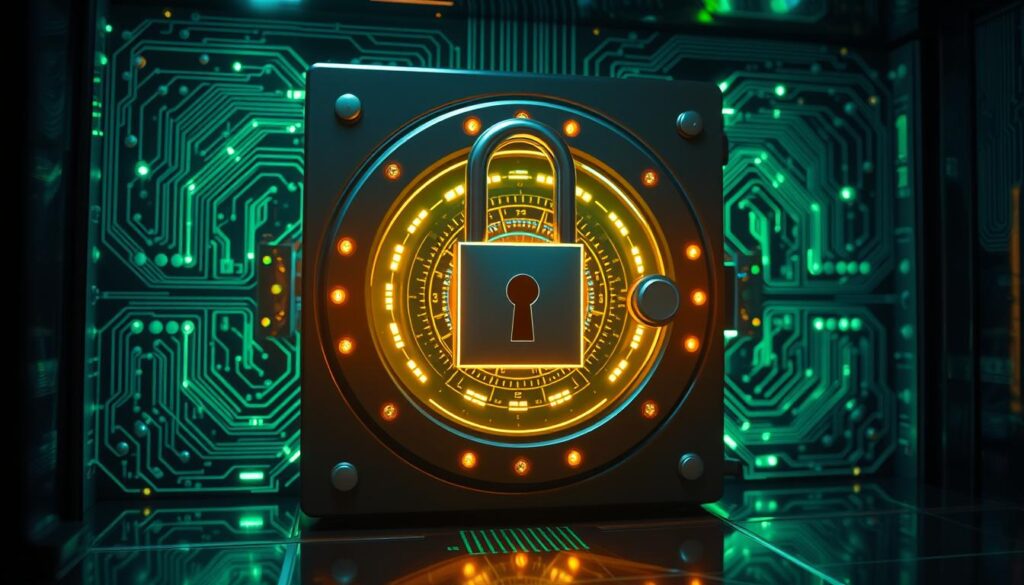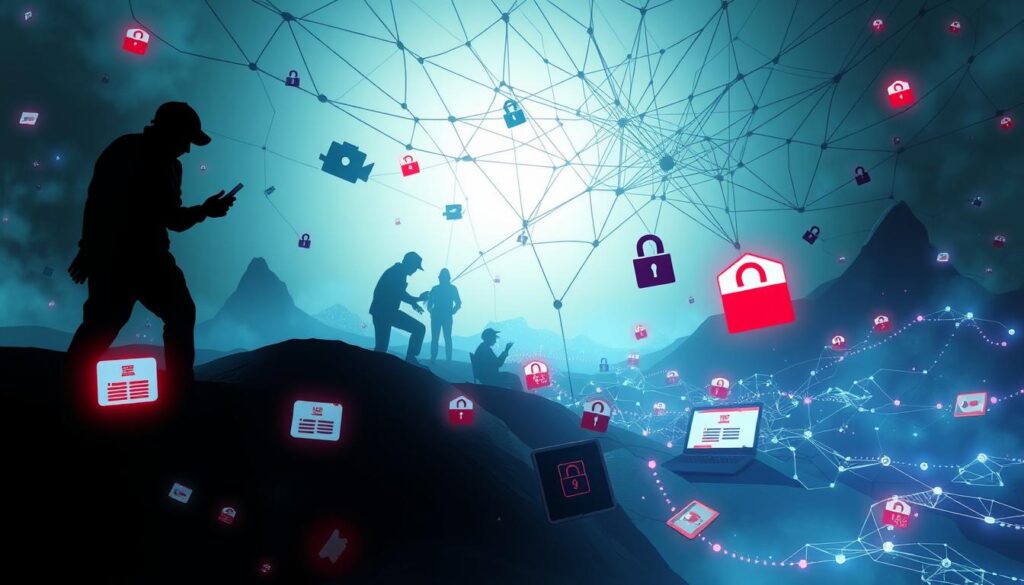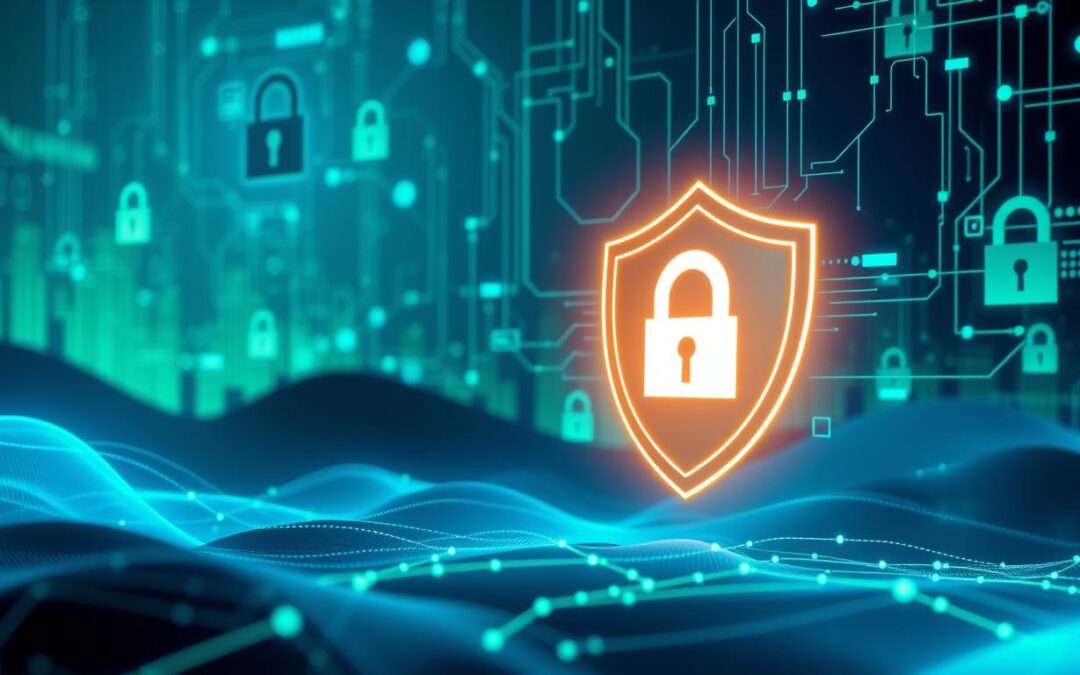October is Cybersecurity Awareness Month. It’s a time to learn more about staying safe online. With cyber threats growing, protecting your digital world is key.
Studies show 70% of people feel more secure in Cybersecurity Awareness Month. They learn about dangers like phishing emails, which cause 91% of cyberattacks. By focusing on cybersecurity, we can lower the risk of data breaches.
Cybersecurity incidents can cost a lot, with the average breach costing $3.86 million. But, using strong security like multi-factor authentication can help. In fact, it can cut down account compromise incidents by 99.9%.
Key Takeaways
- October is recognized as Cybersecurity Awareness Month, emphasizing ongoing education about online safety and internet safety.
- 91% of cyberattacks begin with a phishing email, underscoring the importance of recognizing these threats and prioritizing online security.
- Regular software updates can reduce the risk of vulnerabilities by up to 60%, according to cybersecurity experts.
- Utilizing a password manager can significantly improve overall password strength and reduce the risk of credential-based attacks.
- Following best practices for home Wi-Fi security can reduce the likelihood of unauthorized access by an estimated 75% and improve cybersecurity.
- Cybersecurity incidents are reported to cost organizations an average of $3.86 million per data breach, highlighting the need for robust cybersecurity measures and online security.
- Implementing multi-factor authentication can block up to 99.9% of automated cyberattacks and improve internet safety.
Understanding Modern Cybersecurity Challenges
Cyber threats are getting smarter and can sneak into our lives through everyday actions. The world of cybersecurity is always changing, with new dangers popping up every day. It’s key to keep up with these changes and know how hackers attack.
Ransomware attacks are a big problem, causing huge financial losses for people and companies. In 2024, the average business lost $353,000 to ransomware. Also, network security is a big worry because AI tools can have weak spots that hackers can exploit.
To fight these dangers, it’s important to know about the latest cyber attacks and act fast to protect ourselves. We need strong network security like firewalls and systems that detect intruders. It’s also vital to teach people about cyber threats and how to avoid them.
- 59% of organizations experienced a ransomware attack in the last year, with 70% resulting in data encryption.
- The severity of ransomware attacks increased by 68% in the first half of 2024, with an average loss of $353,000 per incident.
- Global spending on cybersecurity products and services is projected to exceed USD 1.75 trillion during the years 2021 through 2025.
By understanding these challenges and taking steps to protect against cyber threats, we can lower our risk of being attacked. This way, individuals and businesses can stay safe online.
Essential Components of Strong Digital Security
Having strong cybersecurity solutions is key to keeping your digital world safe. This means using cybersecurity measures like firewalls and intrusion detection systems. It also includes data protection methods, such as encryption. These steps help lower the risk of cyber attacks and keep your online space safe.
A solid digital security system has several important parts. These include:
- Network security to block unauthorized access
- Endpoint protection to defend devices from threats
- Data encryption to keep sensitive info safe
By using these cybersecurity measures and data protection methods, you can keep your digital security strong. It’s important to have a multi-faceted approach. This includes constant monitoring and updates to fight off new threats.
Mastering Password Protection and Management
Password protection and management are key to keeping your information safe. Weak or reused passwords cause 81% of data breaches. It’s vital to use strong, unique passwords for each site or service.
Using a password manager can greatly lower the risk of unauthorized access. People who use password managers are 50% more likely to create complex passwords for different accounts.
Experts say a strong password should be at least 12-16 characters long. Also, enabling Multi-Factor Authentication (MFA) can block up to 99.9% of automated cyber attacks. These steps can greatly improve your password protection and management, keeping your digital world safe.

Creating Unbreakable Passwords
To make unbreakable passwords, mix characters, numbers, and special characters. A complex password can take about 31 years to crack with today’s computers. It’s also important not to reuse passwords across different accounts, as it makes you more vulnerable in case of a breach.
Password Manager Solutions
Password manager solutions can safely store complex passwords and help avoid reusing them. With a password manager, you can create and store unique, complex passwords for each online account. This makes managing your passwords easier and more secure.
Multi-Factor Authentication Benefits
Multi-Factor Authentication (MFA) adds an extra layer of security. It makes it harder for attackers to get into your accounts. By turning on MFA, you can block up to 99.9% of automated cyber attacks. This greatly reduces the risk of unauthorized access to your sensitive information.
Network Security: Protecting Your Digital Gateway
Network security is key to internet safety. It keeps your digital world safe from cyber threats. By securing your network, you can stop unauthorized access to your devices and data. This ensures your online security.
Recent stats show firewalls are vital for 64% of organizations. Next Generation Firewalls can block 97% of malware and attacks.
To keep your network safe, consider these steps:
- Network segmentation to reduce internal threats
- Role-based access control (RBAC) to lower unauthorized access
- Intrusion Prevention Systems (IPS) to stop malicious activities
By focusing on network security, you can greatly improve your cybersecurity. This reduces risks from cyber-attacks. Effective security measures prevent disruptions to your business, keeping your online safety and digital world secure.
Data Protection Strategies for Personal Information
Protecting personal info is key in today’s digital world. Cybercrime is on the rise, making a strong data protection plan vital. This includes information security steps like encryption, safe data storage, and regular backups.
Cyber defense is also crucial. It’s about stopping unauthorized access to your personal info. Using strong passwords, enabling two-factor authentication, and updating software are good ways to do this.
Also, being careful with public Wi-Fi and avoiding phishing scams helps. By using these data protection methods, you can lower the risk of a data breach. This keeps your personal info safe.
Here are some top data protection tips:
- Use unique and complex passwords for each account
- Enable two-factor authentication for important accounts
- Back up your important data regularly
- Keep your software and operating systems updated
By following these steps and staying up-to-date with cyber defense info, you can keep your personal info secure and safe.
Social Engineering: Recognizing Human-Based Threats
Social engineering is a big problem in cyber threats, with 98% of cyber-attacks being social engineering. It targets people, not technology. So, it’s key to know about human threats and act to stop them. Always be careful with emails from unknown or shady sources to keep your online space safe.
Some important stats show why we need to be aware of social engineering:
- More than 70% of data breaches start with phishing or social engineering.
- Phishing is behind over 80% of security incidents reported.
- About 90% of successful data breaches include social engineering.
Scammers use urgent feelings like fear to trick people. Phishing emails can be very convincing, with up to 30% of users clicking on them. Knowing these tactics and protecting yourself is crucial for staying safe online.

By knowing about social engineering attacks and how to stop them, we can lower the risk of cyber threats. This means using multi-factor authentication, being careful with emails, and staying updated on new tactics. This way, we can keep our online world safe.
Advanced Cybersecurity Solutions for Home and Office
To keep safe from cyber threats, advanced cybersecurity solutions are key. These include security software, network monitoring tools, and plans for responding to incidents. By using these, homes and businesses can better protect themselves online.
Having good security software is vital to stop malware attacks. For example, Acronis True Image is used by over 5.5 million people worldwide. It has stopped more than 100,000 cyberattacks. It also watches for ransomware and offers identity protection in the U.S. for some subscribers.
Security Software Essentials
When picking security software, look for these important features:
- Advanced Threat Detection to find and stop advanced threats
- Managed Firewall Services to block unwanted access
- Endpoint Detection & Response (EDR) to keep all endpoints safe
These features help make your cybersecurity strong and keep your online world safe.
Network Monitoring Tools
Network monitoring tools are crucial for catching threats as they happen. They include 24/7 Threat Monitoring, which watches all the time for threats. Using these tools helps businesses stay ahead of cyber threats and improve their security.
Building a Culture of Digital Safety
Creating a culture of digital safety is key to protecting people and organizations from cyber threats. It means teaching kids and workers about staying safe online. This helps make the internet a safer place for everyone.
Organizations can start by setting online safety rules for families and work places. They should also keep teaching employees about security. This helps build a safe digital culture at work.
Some important steps include:
- Offering regular security training and awareness programs
- Encouraging workers to report any odd activity
- Using strong security tools like multi-factor authentication and encryption
- Creating a space where everyone feels free to talk about security
By focusing on digital safety, we can lower the chance of cyber attacks. Leadership buy-in is critical in fostering a cyber security culture. Leaders must show they care about security and get everyone involved. Together, we can make the internet safer for all.
Recent numbers show that 85% of data breaches were caused by people. The average cost of a data breach in 2021 was $4.24 million. Building a culture of digital safety can help prevent these breaches and keep our online world safe.
Conclusion: Staying Secure in an Interconnected World
In today’s digital world, cybersecurity is more important than ever. Threats to our online security and digital safety keep changing. To stay safe, it’s key to be always on guard.
Human mistakes often lead to security breaches. This shows why teaching people about cybersecurity is so important. Keeping your software up to date, using strong passwords, and enabling multi-factor authentication can protect your digital world. Also, following rules and doing security checks often can help avoid big cyber problems.
The digital world is growing, and so is the need for cybersecurity. By staying informed and careful, you can safely explore the digital world. This way, you can keep your personal and work life safe from cyber threats.

